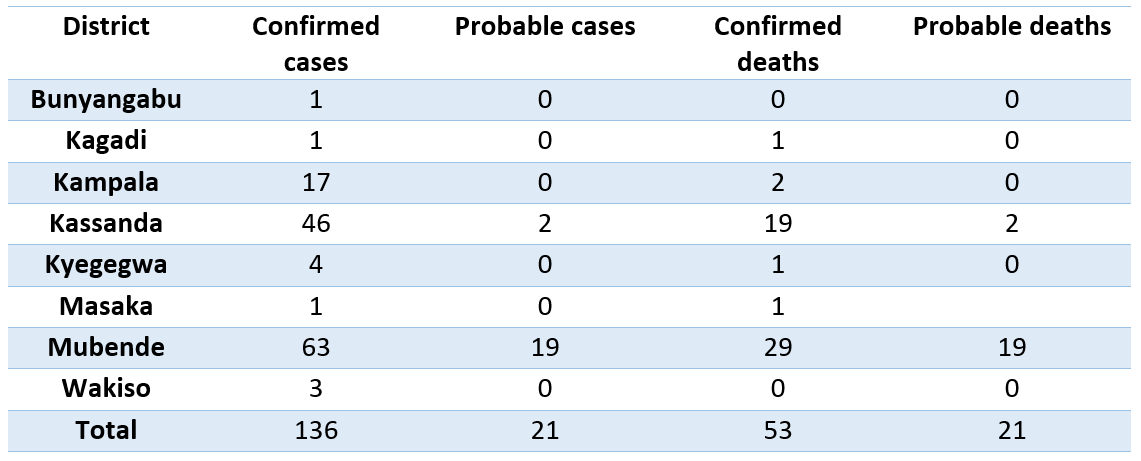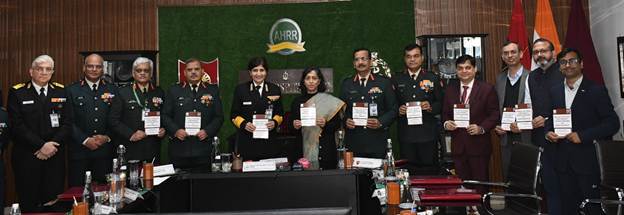
Kampala/Geneva: Between September 20 and November 7, 2022, a total of 136 confirmed cases, 21 probable cases, and 53 confirmed deaths (CFR 38.9%) from Ebola disease caused by the Sudan ebolavirus (SUDV) have been reported in Uganda. These figures represent an increase of 18% and 66% respectively in Sudan since the last figures published by the World Health Organization (WHO) on October 28, 2022.
In addition, 21 probable deaths have been also reported since the beginning of the outbreak, with the last probable death notified on September 29, 2022. Three additional cases and three additional deaths have been reported among healthcare workers since October 28, 2022, resulting in a total of 18 cases and seven deaths among these workers.

Since WHO’s last Disease Outbreak News (DON), one newly affected district has been reported (Masaka), leading to a total of eight districts reporting Sudan ebolavirus cases. The most affected district remains Mubende with 63 (46%) confirmed cases and 29 (55%) confirmed deaths, followed by Kassanda with 46 (34%) confirmed cases and 19 (36%) confirmed deaths. Two districts, Bunyangabu and Kagadi, have not reported cases for more than 40 days.
WHO claimed the government’s efforts to respond to the Sudan ebolavirus outbreak in the district of Mubende, where the outbreak began, appear to be paying off. However, in the past two weeks, the majority of cases have been reported from the capital Kampala, and the district of Kassanda. One case has also been reported from the district of Massaka, in the south of the country.
“The detection of cases in several different districts is clearly concerning,” WHO Director-General Dr Tedros Adhanom Ghebreyesus said in Geneva. “Our primary focus now is to strengthen contact tracing, community engagement, and infection prevention and control measures,” he added.
WHO is continuing to support the Government of Uganda in every dimension of the response, including establishing and equipping treatment centres, providing generators, training health workers and much more. However, to fund its work supporting the Government of Uganda to respond to the outbreak, and to support neighbouring countries to prepare for any cross-border transmission, WHO said it required US$88 million.

As of November 7, 2022, a total of 1386 contacts in seven districts were under surveillance, with a follow-up rate of 92%. In the week commencing October 31, an average of 1586 contacts were followed up daily, a decrease of 16% from the previous week (week commencing 24 October) when a daily average of 1896 contacts were followed up. A total of 34 contacts developed symptoms during the past week. Since the beginning of the outbreak, 3867 contacts have been registered, of which 2237 (68%) have completed the 21-day follow-up period.
As of November 7, 2022, at least 2835 alerts have been received at a daily average of 71 alerts. Approximately 94% (n=2671) of all alerts received were investigated within 24 hours, of which 1120 were validated as suspected cases. The proportion of alerts investigated within 24 hours has been steadily increasing, and in the week commencing 31 October, nearly all alerts (657/659) were investigated within 24 hours, of which 31% (n=203) were validated as suspected cases.
Since the beginning of the outbreak, a total of 2139 samples were collected (suspects, repeat samples, swabs), of which 419 in the week commencing on October 31 (+11% increase as compared to the previous week when 377 samples were collected and tested).
– global bihari bureau





